Bobolink on Tulip Poplar Sapling Transparent Watercolor and Time-lapse Video
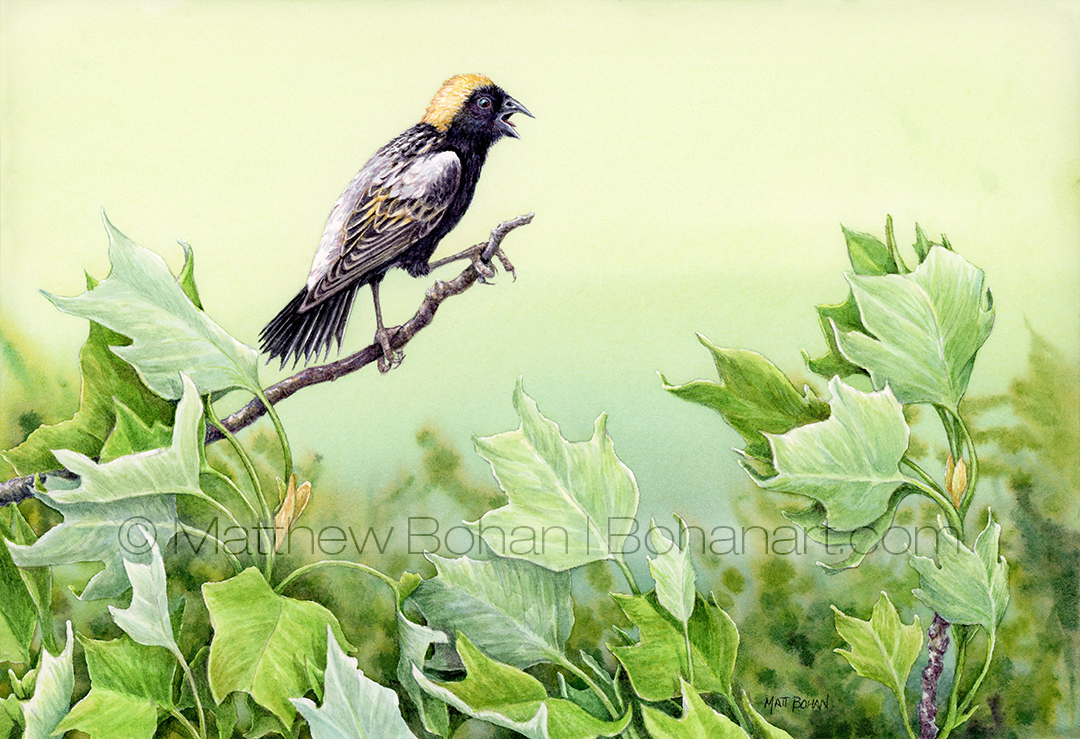
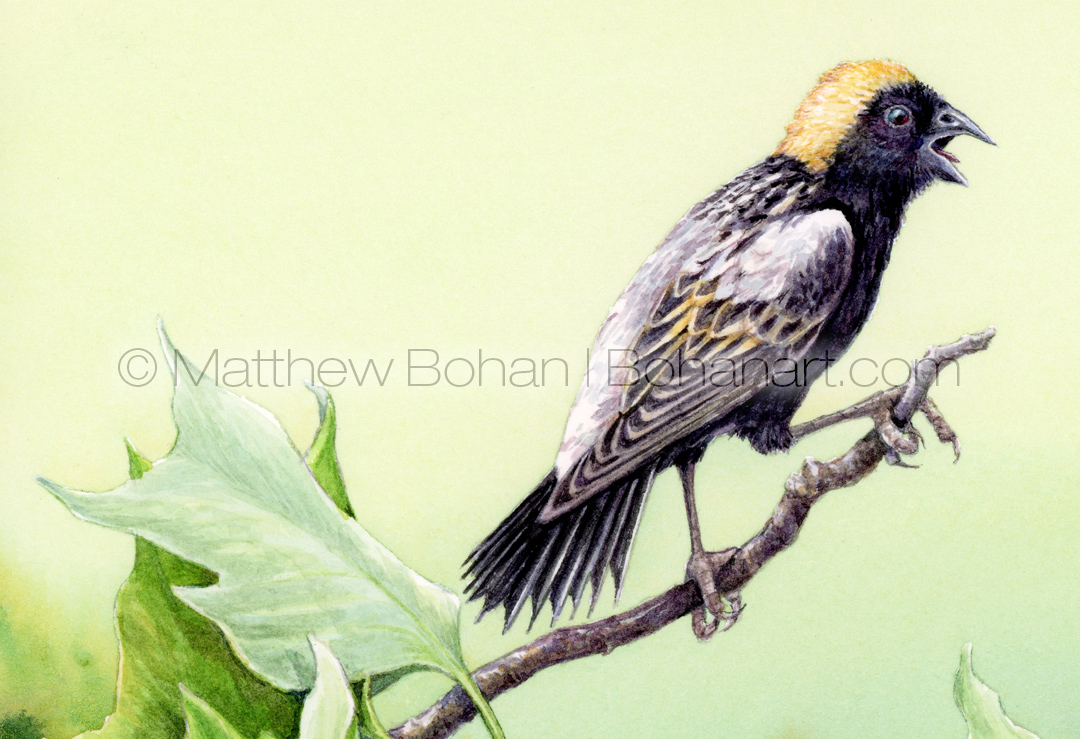
Bobolinks are marvelous grassland birds. Because I grew up in a more forested section of western New York, they weren’t very common. While my life list from that area was packed with warblers and other woodland birds, it was really weak on grassland birds and shorebirds. I didn’t came across Bobolinks until I moved to Michigan. I’ve found them them in the same sorts of habitats as Eastern Meadowlarks, Dickcissel and Savannah Sparrows, which were also not particularly common where I grew up. They have a fun call, and their patterns in flight are beautiful to watch. I still get excited whenever I am treated to seeing them.
I got the photos for this painting about a mile from our house. While walking our dog I spied a pair of Bobolinks calling from a sapling tulip poplar near the local high school’s baseball field. The birds stayed for a week or two before departing. I was incredibly hopeful that they might breed on the site, but they had other plans. Over the years we have seen a lot of unusual birds at the cross-country trails and ponds near that school. Other highlights there of things uncommon in our area include Bald Eagles, Osprey, Trumpeter Swans, Red-headed Woodpeckers and a Northern Mockingbird.
Dimorphic Jumping Spider on Redbud Leaf Transparent Watercolor and Time-lapse Video
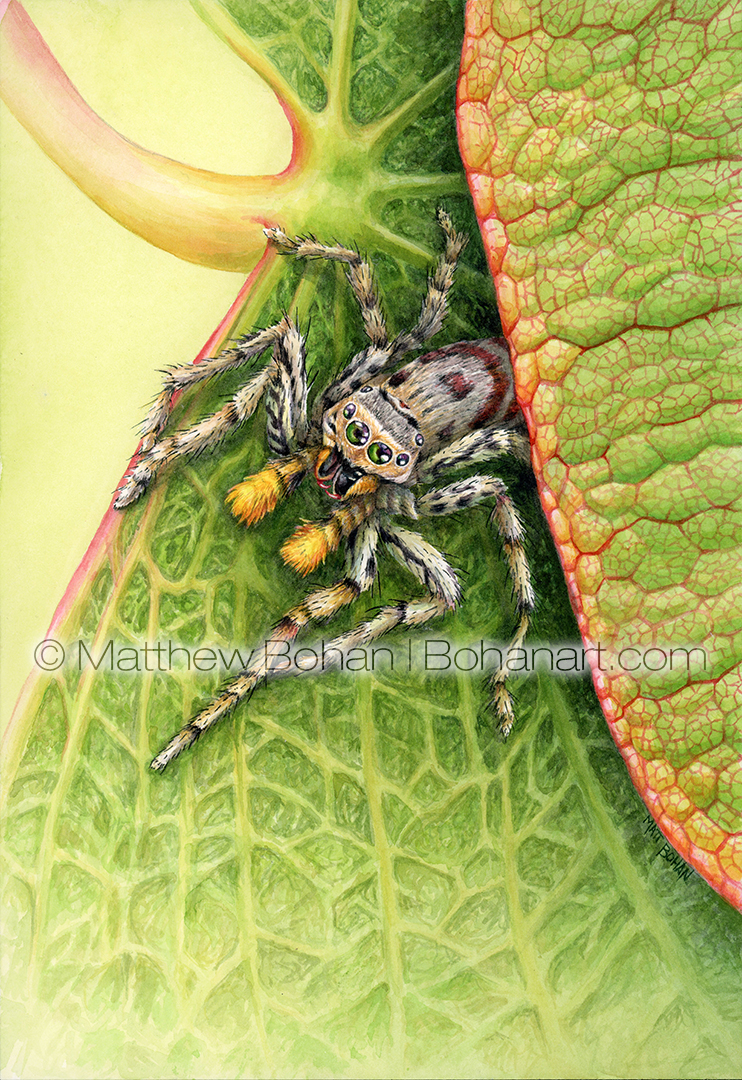

Jumping spiders have fascinated me since I was a little kid. My brothers and I would find several varieties of them on a retaining wall near the swimming pool that we frequented in the summer. That made the seemingly endless “Adult Swim” sessions go by a little faster while we waited for the octogenarians to finish soaking their copious liver spots.
Honestly, looking for jumping spiders was the runner-up to our all-time favorite adult swim time-burner… the towel fight. This event usually featured my brothers and one cousin. Other kids occasionally joined in, but for some reason they never seemed to come back. “Normal” participants would simply twirl a towel around and go about snapping the twisted towel at each other. Our version was much more Lord of the Flies. There was a long and elaborate folding process involved in wrapping the perfect whip-like towel. Each kid seemed to have their own idea of what was the best method. My brother Ted was the undisputed champion. He even generously showed me how he transformed his towel into a world-class weapon. I think that deep down he knew I wasn’t a threat, because I’d never have the patience or dexterity to painstakingly fold, then slowly and tightly compress while accurately twisting a towel into what ended up looking like, acting like and sounding like a bullwhip. Most participants’ towels lost their compression and strength after a dozen shots, but Ted’s would never fade during the call of duty.
Towel fights were strictly forbidden in the regular pool area, so once the lifeguard called “Adult Swim,” the combatants would sneak off to a quiet area nearby to begin the battle. There were basically only two rules with the towel fights: #1 No head shots, and #2 No wetting the towel tips. Early on some kids dipped the corner of their towel in the pool before a towel fight. The extra mass at the end allowed for a better “crack to the whip.” This caused two rather visible problems that threatened to spoil the fun. First, welts and bruises starting showing up regularly. That was easy enough for our moms to shrug off. It was just “Boy Stuff” that could be caused by anything and, more important, it would just heal up. Second, our mothers started noticing that the corners of our towels were ripped and tattered up to 4 inches from the edge. This was way harder to explain. Was this batch of beach towels defective??? So, wetting the towel tips had to go. When left dry, the corners held up much longer. The last great towel fight ended rather spectacularly when my brother Ted cracked our cousin Mike on the thigh and opened up a 3- to 4-inch laceration that bled almost instantly. At first, we thought he was just acting, but no… that was a nasty looking abrasion that seemingly evaporated the entire top layer of his dermis. I’m sure dipping that fresh sore in the heavily chlorinated pool water was no relief for the pain! Occasionally someone new would start to join us, but after seeing the beginning of the melee, they would decide to sit back and watch. I suppose that by keeping it all the family, we were probably a little less civilized than if we had to worry about injuring an outsider.
Oh yeah, this is supposed to be about jumping siders! We’d usually start looking for the spiders after the towel fights got out of hand and someone got hurt. There were always plenty to find, especially on sunny days along the retaining wall near the expansive patio where our fights often took place. I’m still not exactly sure what they found to eat. This was adjacent to a heavily manicured golf course, so there weren’t many insects around. Maybe they were feasting on other jumping spiders or gobbling up the flies attracted to the patio where food would be served later in the day.
Jumping spiders are much more interactive than the orb weaving spiders that people normally think of. Although jumpers have eight eyes, it isn’t unusual to have them return your gaze with their largest front-facing set. They seem inquisitive and adventurous. Around our house the most common jumping spider is the Dimorphic Jumper, which comes in two “flavors.” More frequently we find the gray variety, in which the male has bright yellow pedipalps and rusty red markings on the top of its abdominal segment. The other color morph is an attractive black and white variety. You’d never guess the two spiders are the same species. The Black and White Jumping Spider even has crown-like triple-tufted spikes on its head that are completely lacking on the Gray Morph. I usually find these critters on the siding of the house. Yesterday, after finishing a bike ride, I saw three gray ones within a two-foot section of siding next to the garage door opener. (!)
The other common jumping spiders that we get on the siding and in the house are the large Daring jumpers, which we usually call “Shelob,” as well as Zebra jumpers and Tan Wall jumpers, which I usually call the moustached jumpers.
The hardest part of this painting was the macro view of the redbud leaves. I wanted to have a fade-in detail and focus as the image went down the page. Keeping things relatively loose at the bottom was against my usual nature but a fun challenge.
Lincoln’s Sparrow Transparent Watercolor and Time-lapse Video
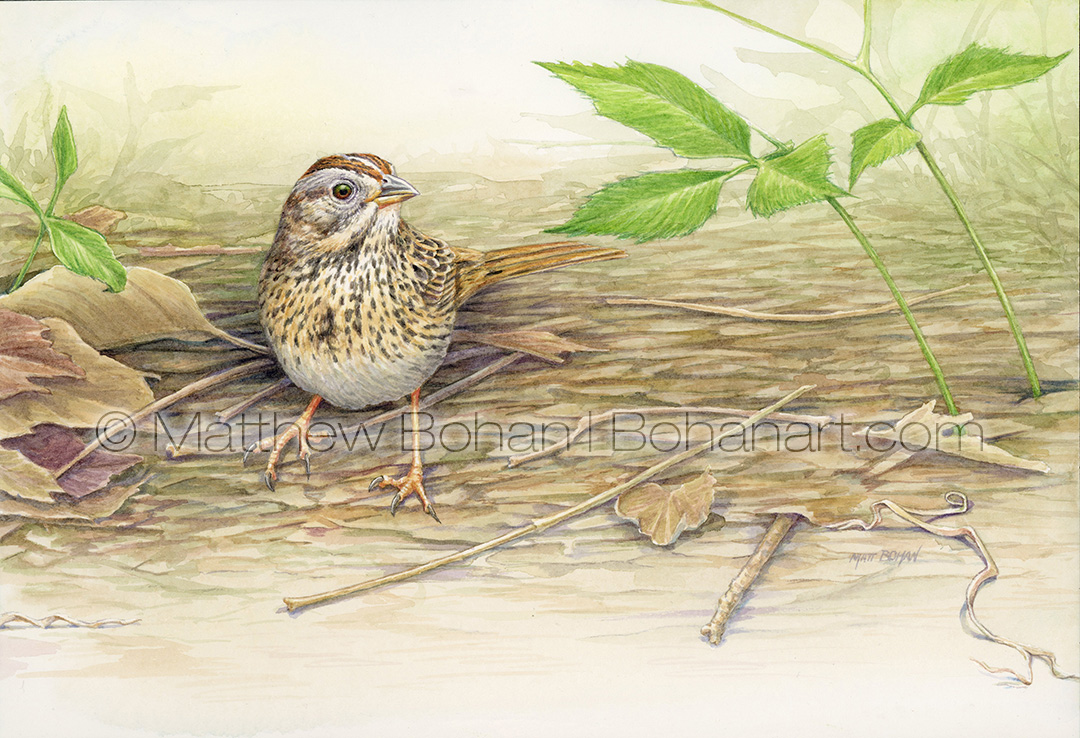
Lincoln’s Sparrows are easily missed, which is really a shame. They are small, shy birds that like to skulk around in the underbrush. Like many of the sparrows, they are “Little Brown Jobs” that reward those who are willing to appreciate the subtleties that make them unique. Early in my birding experience I wasn’t aware of these little treasures. Like many beginners, I took on yard birds first and then moved on to waders and waterbirds. Later, warblers attracted my attention with their flashy, bold, saturated colors. As I became a better birder, I found that sparrows are also rewarding, with a diverse and fantastic palette of subtle earth tones in refined patterns that make perfect camouflage. It’s hard to pick a favorite sparrow, but I can tell you that I’ll never get tired of looking at Lincoln’s.
In my experience Lincoln’s Sparrows typically afford a brief peek before disappearing into the brush. I saw my first one ages ago at the edge of the parking lot; that was after a long day of May birding at Magee Marsh in Ohio. Since then, I’ve seen them many times, but my hands-down favorite is a bird that visits our yard for a few days each May. I can’t prove it’s the same individual, but for several years we’ve had a single Lincoln’s Sparrow show up and work its way along the eastern hedge of our yard, mostly foraging in the low plants and leaf litter near our ninebark shrubs. I’ve never seen it venture to any other part of the yard, despite having similar habitat in other areas. Usually it hangs around for 2-3 days and then moves on. This year it stayed for more than ten days. In addition to the usual suet logs, I had been putting a small dab of suet in a spot near the ground for American Robins and Gray Catbirds. Well, that little Lincoln’s Sparrow discovered the suet and fueled up every few hours. It was a treat for the bird and for our family watching from inside.
After getting plenty of shots of the cooperative bird from the kitchen window, I knew it would make for a fun painting.
Crested Coua Watercolor and Time-lapse Video
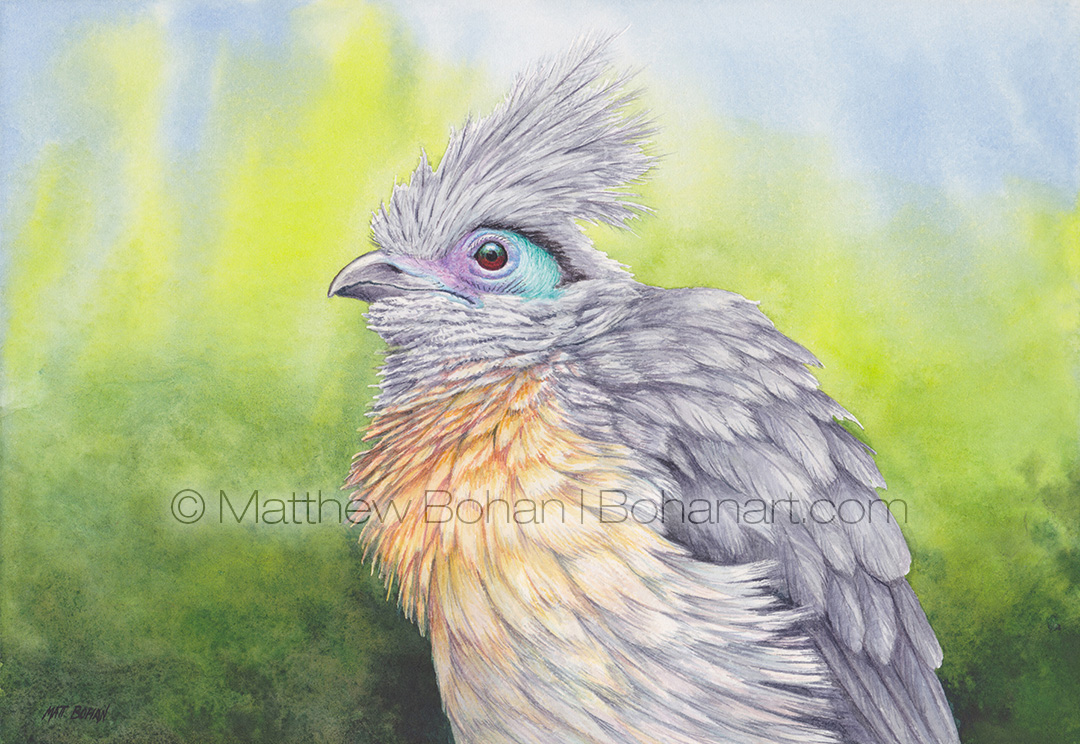
I’m still trying to post all the art that’s been accumulating. May is always a busy month for birding, and this was no exception. On top of that I’ve been swamped with illustration/animation work.
This painting is not in chronological order. Before this one I completed a complex watercolor of Black-capped Chickadees, and it’s taking a long time to edit those videos. After that long, difficult piece, I was in the mood for something I could wrap up quickly. Fortunately, a sketch of a Crested Coua from the Toledo Zoo was ready to go!
The Crested Coua, like all couas, can only be found in the savannas and brushlands of Madagascar. There are only nine species in the genus. They reside in the family of cuckoos, but unlike some of the cuckoos, couas build their own nests. Many cookoos are nest parasites and lay their eggs in the nest of a host who then broods, hatches and raises the parasite’s young. The Crested Coua eats fruits, nuts, insects, seeds and the occasional small animal.
Having never been to Madagascar, my experience with these beautiful birds has been confined to seeing them in zoos. They are fairly big birds and are spectacularly beautiful. My daughter described them as a “Giant Glam Titmouse.” That pretty much hits the nail on the head. The crest and overall coloration are very similar, with the addition of some spectacular “eye shadow” on the bare flesh around its eyes.
When reviewing my site and social media analytics to see which paintings seem to attract the most interest, I was a little surprised to see that the simpler paintings are more popular. Generally speaking, the most highly designed, larger paintings that take forever to finish seem to get the least hits, and a quick, simple painting of a bird with a blurry background and little design work gets more attention. This would make a sane person reluctant to spend over a hundred hours on a complex painting, rather than ten or so hours on a simple one, but I’m not that guy. I consider the complex, highly designed ones to be more “art” and the simple ones to be more “illustration,” not that there isn’t a ton of crossover between the two. Since I’m primarily painting for my own entertainment, I’ll continue to mix it up and do whatever captures my interest. A sure way to please no one is to try to please everyone.
Grumpy Chestnut-sided Warbler Transparent Watercolor and Time-lapse Video

Sorry for the delay in posting new material. It has been a crazy few months. Medical illustration and animation projects have been keeping me super busy. No worries—I have kept up with my watercolor paintings. I just fell WAY behind on posting work here, on YouTube and Instagram. Something had to be sacrificed, and I’d rather spend the time painting than writing posts, scanning, editing video and posting. Although this painting is being uploaded at the perfect time for spring migration, it was actually created in the dead of winter.
I can’t remember the last time I painted the same species as the main subject of two consecutive paintings. A Chestnut-sided Warbler is certainly worthy of back-to-back efforts. I seldom render birds face on because they can look strange or grumpy. At the same time, why not do something out of the ordinary? Those typical side views can get a bit predictable. A bird staring right in your face, well… that commands attention! This isn’t a popular angle for rendering birds because it tends to flatten out the beak. I’ve only used this view on a handful of occasions. One the plus side this also makes them look quite human. Sometimes looking grumpy, other times cute. This guy certainly morphed into an almost perfectly spherical shape.
Over the past year I’ve been working on a few different things with my watercolors. Getting detail isn’t a problem for me. I’ve really been trying to hone my abilities to create convincing depth of field, selective focus and convincing lighting. Finding a good balance between detail and hard edges versus soft and fuzzy is hard. I’m definitely feeling more comfortable now working into and out of the detail in backgrounds—from highly detailed to more suggestive.
It was a fantastic winter with some absolutely stunning snows. We enjoyed a Pileated Woodpecker’s almost daily visits to the suet feeders outside our kitchen window. Other treats were Evening Grosbeaks, Purple Finch, Common Redpolls and Red-breasted Nuthatches. We live on the northern end of the Carolina Wren’s range. Over the past few years we have had a pair overwintering and then nesting in our yard. We really worry about them when the cold and snowy weather hit, and keep our feeder stocked up with peanuts for them. They made it through winter again but chose to nest elsewhere. While we had great birds and beautiful snows, it has been nice to welcome “our” orioles, catbirds, warblers and blossoms back to the Michigan landscape!
Singing Chestnut-sided Warbler Transparent Watercolor and Time-lapse Video
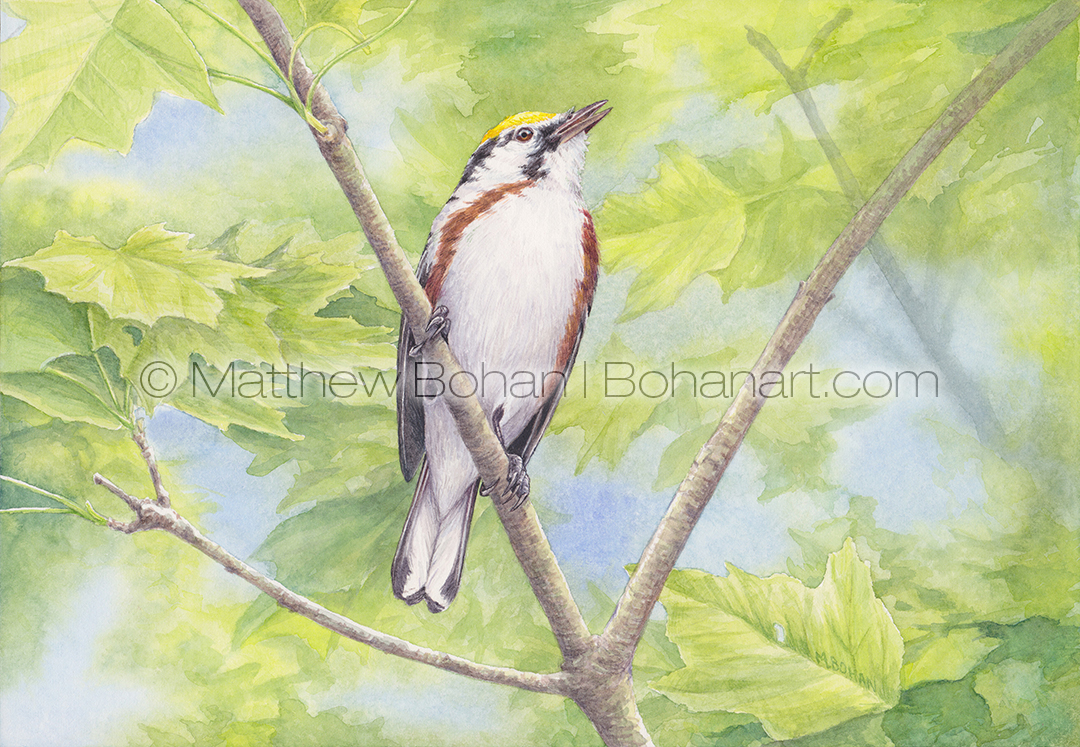
I have to admit that I’m a bit nuts about warblers. While I have a lot of “holes” in my life list in the area of shorebirds, I’ve managed to see every eastern warbler with the exception of just one, the Swainson’s. I really need to get that one! My favorite place to go birding is in wooded areas, so I’ve had high yield with warblers over the years. It is hard to overestimate the appeal of these cute, brightly colored birds.
While it is virtually impossible for me to pick a favorite warbler, the Chestnut-sided certainly is a class act. For a bird that is dominated by mostly white feathers, it is striking, with stripes in all the right places. As much as I like their breeding plumage in the spring, their fall colors make them about the cutest things around. Once I get good reference photos, I seriously need to paint one.
This painting was a little out of my comfort zone. I tried to not overwork it. One of my main goals was to have a blurry background that faded in and out of focus. That’s really easy to do with an airbrush, but it’s a lot harder in watercolor… at least for me. I hoped to capture some of that soft focus look that I like from airbrush. I wanted to selectively focus the scene using detail in some areas fading off to other areas with super soft edges. Thankfully, I’m happy with the results.
As a kid I don’t recall seeing many warblers. I remember looking through a copy of Peterson’s Field Guide to Eastern Birds and being in disbelief that all those beautiful birds were theoretically within our range in western New York. Where were they hiding? I remember seeing lots of feeder birds, Indigo Buntings, Eastern Bluebirds and bigger birds like hawks, turkeys, herons and grouse, but the little jewel-like warblers were an enigma.
Once I came across a spectacular little brownish-blackish bird with orange marks on its wings that was lying stunned on the ground, probably from striking a window. I gently picked it up and marveled at its perfection. I moved it to a safe spot in the crook of a big tree, returning half an hour later to find that it had flown off. Once back in the house, I rifled through Peterson’s guide and keyed out my first American Redstart: a perfect male specimen.
After that I started to become obsessed with finding warblers. I learned quickly that they are incredibly tiny, lightning fast and, despite being brightly colored, incredibly well camouflaged in the field. In addition, I was really disappointed to realize that most of those feathered jewels only passed through our area on their way to their breeding or wintering grounds. That certainly made the month of May exciting, searching out new friends. Of course, when they returned in September, many were disguised in their fall plumage. Decades later the obsession still runs strong and has “infected” the rest of the family. For us the months of May and September revolve around birding; those are the warbler months. Car trips and vacations usually involve a consultation with eBird.org to see what hotspots might be along our way. No, we aren’t addicted… honest!
Blue-winged Warbler Transparent Watercolor and Time-lapse Video

A simple, fast painting of a Blue-winged Warbler seemed like the way to go after my last big painting of orchids, which had tons of detail.
A piece of advice that I always give aspiring artists is to work on your weaknesses. After 25+ years of illustrating professionally, I still find plenty of areas that I need to polish. Watercolor has a reputation as a beginners’ medium, but in actuality it is difficult to “tame.” For this piece I wanted to hold back on the level of detail. My goal was a super-soft background like ones I used to create with an airbrush, but with the detail receding as the branches move into the distance. That isn’t the easiest task in watercolor, so it was a good challenge. I also don’t use pastel shades much, so I thought it would be a fun change of pace.
I really love these beautiful little guys with their cheery “bee buzz” call. I don’t recall seeing many of them back in New York and New Jersey. Here in Michigan they pop up a fair amount, but I haven’t seen quite as many locally over the past few years. They used to be regulars on my mountain bike route, but that particular part of the trail has changed a lot, and they seem to have picked other areas to breed. In the spring and summer I used to hear them calling all the time as I’d zoom along the trails. In the spring I always pocket a set of old Minolta mini binoculars in case I hear anything interesting on the ride. Once migration is over I tend to eject that extra weight so I can go a little faster and work on my Strava times.
Those ancient Minoltas are pretty awful now. They’re beaten up and have fungus growing in them, but I saw so many great birds with them that they will always have a special place in my memory. Since they are small, I used to carry them almost everywhere. Years ago when the kids were super young, I let my son use them, and they were briefly introduced to Lake Erie. Oops! Things happen. After an exhaustive disassembly, drying, lubrication and reassembly, they were functional again. It’s a great thing for a kid to have a pair of binoculars that are small, light and affordable enough to be replaceable. Our kids didn’t have fancy optics when they were small, but they had functional hand-me-downs that fueled their love of birds and other animals.
I often see lists of binocular recommendations for kids, and they are always more expensive than most people can reasonably afford, especially parents whose kids are interested though they are not. While a bird nerd parent might not mind dropping a few hundred dollars on field glasses, your average Joe might prefer not to. Those lists always skip the compact binocular styles. I agree that they aren’t ideal for seasoned users, but small kids don’t like having heavy things strapped around their necks. Even though a set of 8×40 or 8×30 porro prisms are easy to use, they are definitely big and heavy. If a kid won’t carry them around, such binocs are useless. Most compacts are lightweight and can be adjusted to fit small faces. I also think you need to factor in the possibility of losing them completely, either on a hike or in a pond, river or ocean, so being able to replace them is pretty important. While the compact pairs are lousy in low light, that complaint was seldom voiced by our kids.

Orchids on Blue Transparent Watercolor and Time-lapse Video

I had so much fun with my last orchid painting that I thought it would be worth revisiting such a diverse and fascinating subject again. This one took a long time to design. I spent days monkeying around with all sorts of possibilities. At one point I got frustrated enough that I was ready to put it away for a week or two and start on a more straightforward painting. I kept having trouble coming up with ways to unify all the smaller images in an interesting way. While sleeping, the idea of the “oval-ized” shapes in the background came to me. When I woke up I figured it was worth a shot! I was pretty pleased with the new oval background versions I made in Photoshop, so I moved on to transferring the sketch and painting.
It’s funny that over the years I’ve had that happen a lot. I’ll go to sleep with a design, 3D modeling/animation, wood-working or other problem on my mind, and in the middle of the night, while the old grey matter is still churning away at the problem, up pops a solution.
Ok… on more than one occasion I’ve had a fantastic, incredible solution to a problem in my dream and awakened excited, but the next morning in a more lucid state, I realized how utterly moronic my sleep idea was. Oh well, you can’t win them all. You also can’t bank on sleep ideas happening at all. Most of the time I wake up with the same unsolved puzzles rattling around in my head. I am a firm believer in letting things percolate in the synapses for a few days, just in case.
Like my last orchid painting, I wanted to do something that was not a typical floral painting or botanical illustration. I decided to only paint the flowers for the most part, not stems and leaves. The stems, leaves and roots of orchids can be beautiful, but I wanted this to be really different from most of the botanical paintings and illustrations I see, which are cut flowers or specimens on stark white.


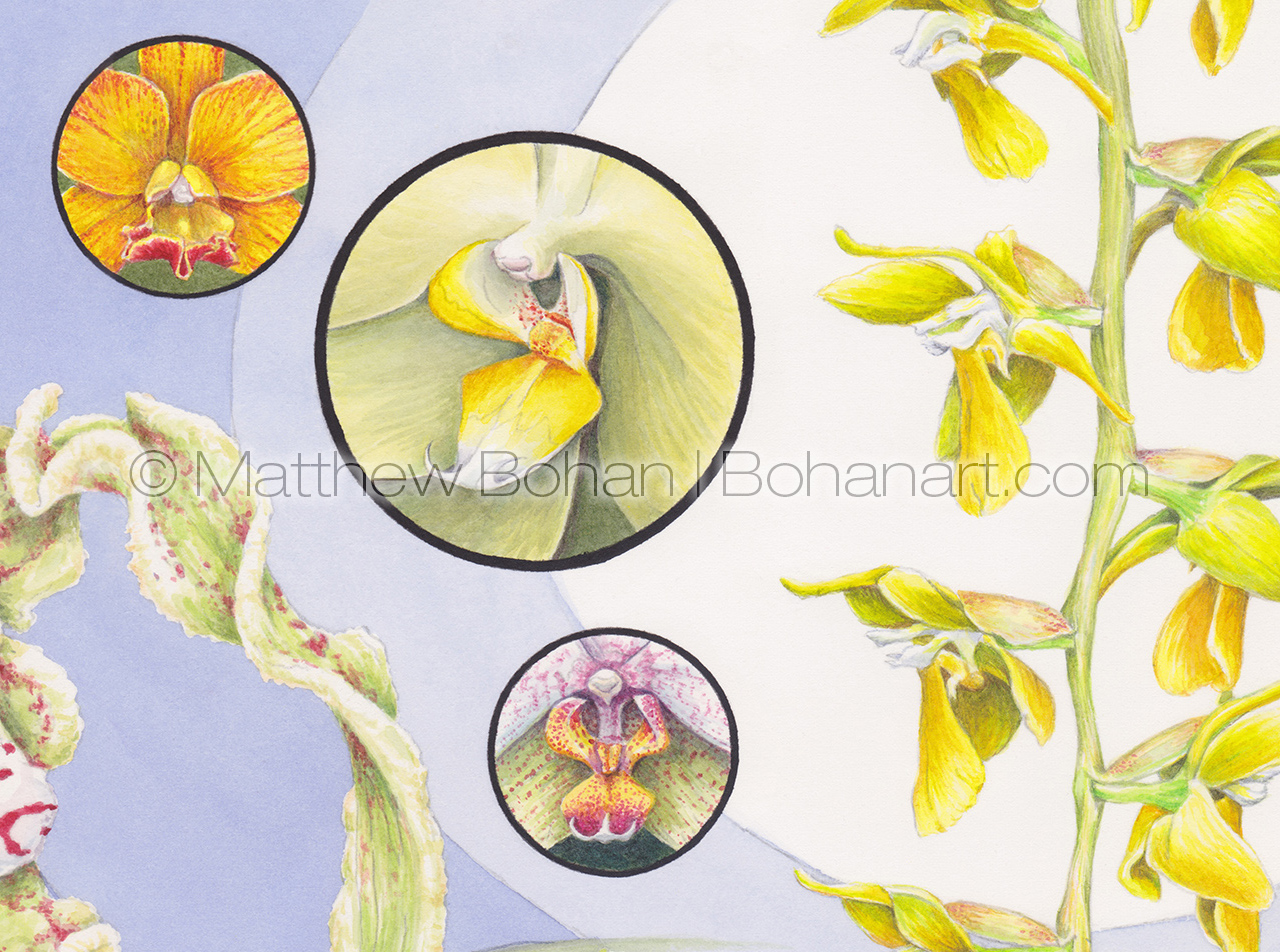
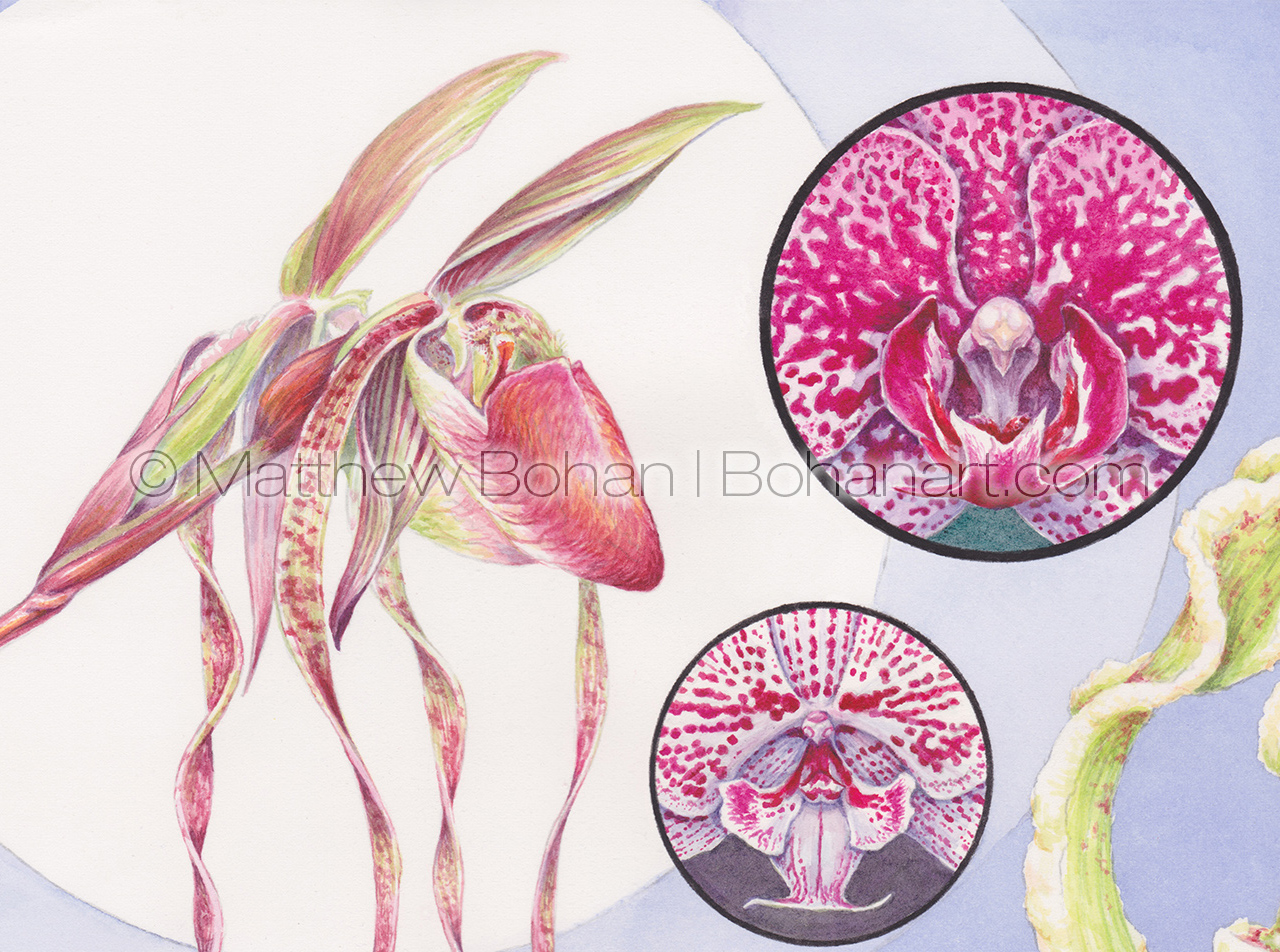
Thick-headed Fly Transparent Watercolor, Gouache and Ink plus Time-lapse Video

I needed a quick project that I could wrap up between animation assignments. This Thick-headed Fly seemed like the perfect subject matter. This was a bit unusual for me because I pulled out the gouache paints for a few things late in the painting. Typically I do everything in transparent watercolor. On this one I wanted to add some colored hatching to portions of the leaf, specifically the white edge to the leaf and some of the orange line work on the bottom of the leaf.
Thick-headed Flies are interesting insects. Like the bees and wasps they resemble, they eat pollen and nectar from plants. When I was first photographing this insect, I thought it was a wasp. As I got in close with the macro lens, I noticed that it had halteres, rather than hindwings, which you’d expect to see in bees and wasps. In the painting you can see a small whitish sphere under the wing. Because of the angle, it’s facing right at us, so it isn’t a great view. At most angles they look like a ball on a stick. That’s one of the two halteres found in dipterans, the true flies. Halteres are vestigial wings that are shrunken down and act as mobile counterweights during flight. True flies have only forewings and a set of these counterbalances. Interestingly, all true flies, like the “Fruit Fly,” have two wings and are named with “Fly” as a separate word. Any of the animals with a “-fly,” like Dragonfly, Damselfly and Dobsonfly, aren’t true flies.
There are numerous species of thick-headed flies. They all mimic bees and wasps to avoid predation. No one wants to mess with a stinger and a bad attitude. But wait, there’s more! The strangeness doesn’t end there. All thick-headed flies are parasitic. Adult females will attack bees in flight, grabbing them and then injecting an egg into the abdomen of the victim using a harpoon-like ovipositor. The developing larvae eats the hemolymph of the host, eventually eating other organs. Strangely, in many cases the parasitic larva causes a behavioral change in its host. The bee starts digging itself into the ground until it is buried. The host dies while the larvae inside pupates in the safety of its underground home, emerging from the host’s decaying body and the dirt ready to start the lifecycle anew. Truth is sometimes stranger than fiction. It would have been suitable for an old episode of the “X-files.”
Wilson’s Snipe Transparent Watercolor and Time-lapse Video
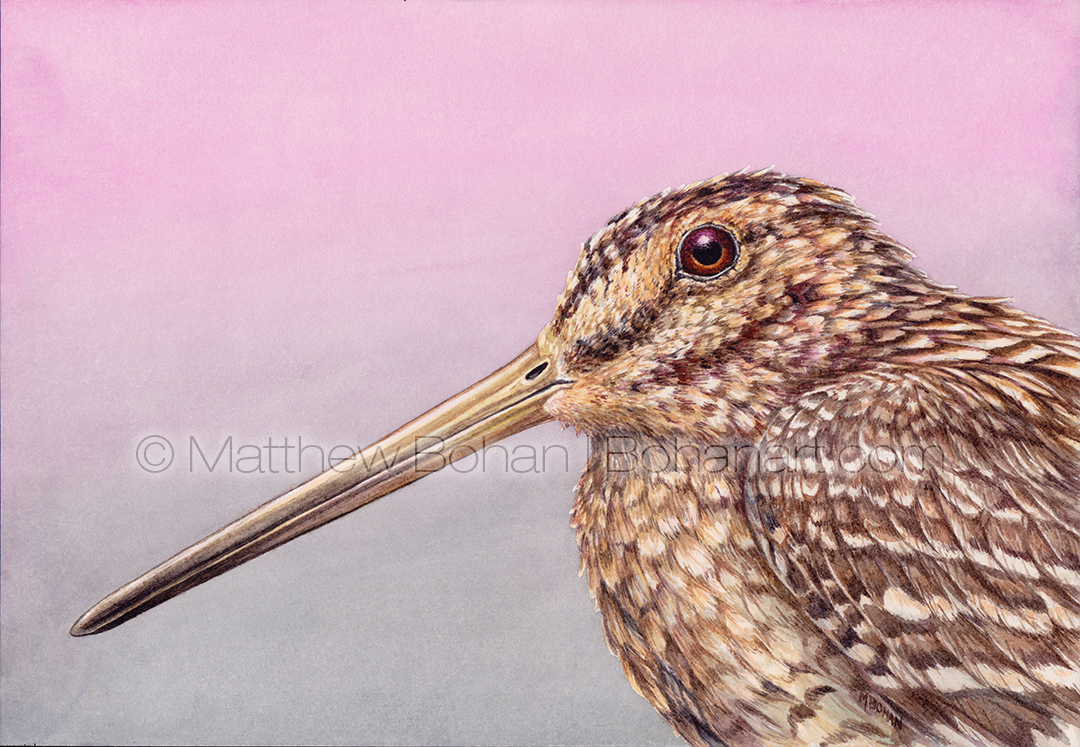
This painting is being posted out of sequence. That’s the hazard of being behind. After a series of highly designed paintings and several medial animations for clients, I was desperate to get something on the drafting table quickly so I could start painting again. I rifled through my sketchbooks to see what was ready to go. Over the past few years, I’ve invested a lot of time in detailed backgrounds and have avoided more straightforward images such as simple bird portraits and “bird-on-a-stick” paintings with uncomplicated backgrounds. Strangely, the simpler paintings tend to be among the more viewed images in terms of web hits, so maybe I’m wasting my time? In general, I prefer seeing more elements on the page. I find them more intriguing compositionally. I’m mostly painting for my own entertainment, so I might as well keep “me” happy.
Of course, when I’m under a time crunch, simple portraits and backgrounds are much more appealing! So when I came across the sketches I did from my photos of a Wilson’s Snipe at MSU’s banding station, I thought it was the perfect candidate for a “quick” painting. Strangely, snipes are not typically found at that banding station, which is in a wooded location. My reference had a lot of blurred out trees. They were nice shots but not typical habitat for a snipe. I chose to put in a smooth, blurry pink to purple-gray fade to suggest some atmosphere while also allowing for some interesting interplay with all of the tans, browns and blacks of the bird.
